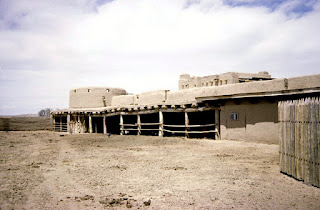Trading Post: Old Fort Bent, La Junta, Colorado
Traders in western North America could either work for one of the larger trading companies, Hudson's Bay in Canada, or Astor's American Fur Company, or they could start their own firms. The Bent brothers, Charles and William Bent, with their partner Ceran St. Vrain, decided to form their own company, trading with the Arapahoe and Northern Cheyenne. They built several forts, Fort St. Vrain in Weld County, Colorado, Fort Bent in Otero County, and Fort Adobe, in Texas. Built in 1833, Fort Bent was the westernmost point of White settlement on the Santa Fe Trail leading from Independence, MO, to Santa Fe, NM. The Bents also had company stores in Santa Fe and Taos, bringing trade goods from the east, over the Santa Fe trail, to trade with Natives for furs, particularly buffalo pelts.
Old Fort Bent was made of adobe and quickly became a stopping point for emigrants heading west, explorers, even units of the United States Army. Traders such as the Bents, relying on their network of mountain men and Natives, were invaluable sources of information about rivers, mountains, sources of water and the dangers of various trails. Most of these trading posts were short lived and in 1849, a cholera epidemic among the Native tribes caused Bent to abandon this fort. He made his headquarters at Fort St. Vrain, leaving Old Fort Bent abandoned. In 1849, the fort was burnt and its walls caved in a deliberate destruction. Though the perpetrators remain a mystery, one plausible theory was that whoever it was tried to halt the spread of the cholera contagion by destroying the fort with fire. Such was a common practice for both Whites and Natives.
Archaeological digs on the site confirmed the layout and building materials of Old Fort Bent. It was designated a National Historic Site and National Historic Landmark in 1960, and added to the National Register of Historic Places in 1966. In 1976, reconstruction of the fort began on the site. Visitors can see and tour the reconstructed fort, learning what a trading post on the Santa Fe Trail was like.
Old Fort Bent was made of adobe and quickly became a stopping point for emigrants heading west, explorers, even units of the United States Army. Traders such as the Bents, relying on their network of mountain men and Natives, were invaluable sources of information about rivers, mountains, sources of water and the dangers of various trails. Most of these trading posts were short lived and in 1849, a cholera epidemic among the Native tribes caused Bent to abandon this fort. He made his headquarters at Fort St. Vrain, leaving Old Fort Bent abandoned. In 1849, the fort was burnt and its walls caved in a deliberate destruction. Though the perpetrators remain a mystery, one plausible theory was that whoever it was tried to halt the spread of the cholera contagion by destroying the fort with fire. Such was a common practice for both Whites and Natives.
Archaeological digs on the site confirmed the layout and building materials of Old Fort Bent. It was designated a National Historic Site and National Historic Landmark in 1960, and added to the National Register of Historic Places in 1966. In 1976, reconstruction of the fort began on the site. Visitors can see and tour the reconstructed fort, learning what a trading post on the Santa Fe Trail was like.




Comments
Post a Comment